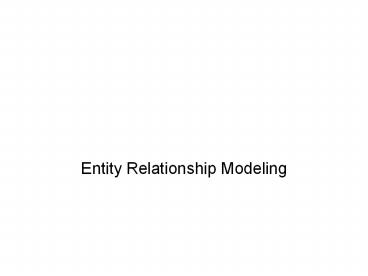Entity Relationship Modeling PowerPoint PPT Presentation
1 / 13
Title: Entity Relationship Modeling
1
- Entity Relationship Modeling
2
Topics
- Real things and descriptions
- Example for the workshop
- Implementation into RDBMS and XML
- ER models as abstract models
- Modeling as a language task
3
Real things and descriptions
4
The timetable data model
As Relational tables
Route ( routeno, destination, bay)
Departure ( routeno, dtime )
SELECT FROM route NATURAL JOIN departure
5
As XML
- ltroutegt
- ltroutenogt99lt/routenogt
- ltdestinationgtCentre via Blackboy
Hilllt/destinationgt - ltbaygt2lt/baygt
- ltdeparturesgt
- ltdtimegt7.00lt/dtimegt
- ltdtimegt720lt/dtimegt
- lt/departuresgt
- lt/routegt
6
ER models are abstract
- Relationships
- Datatypes
- Stored / derived data
- Identity
- Constraints
- Subtypes
7
Types and Subtypes
8
RDBMS implementation
- In Oracle 9i and Postgres, we can implement this
type/subtype relationship directly, but in SQL-92
DBMSs we will have to do some work to achieve
this. - Generate two tables, one for each of the
subtypes each table will contain the common
fields - salariedEmp (empno, ename, job, mgr, hiredate,
sal, comm) - contractEmp (empo, ename, job, mgr, hiredate,
hourlyRate, contractHours) - Generate three tablesone for the supertype and
one for each of the subtypes - emp (empno, ename, job, mgr, hiredate)
- salariedEmp (empno, sal, comm)
- contractEmp (empno, contractHours)
9
Modeling and Language
- Modeling as Lego
- you need the ability to understand how the UoD is
structured (analysis), you need knowledge of how
all the different kinds of blocks work, what fits
with what and then the ingenuity to use the
blocks to create the closest possible model - misapprehensions
10
Creativity in naming
- Guidelines
- names of entities must be singular, not plural
naming the entity type, not the entity set - the name of entity should match the name of the
real-world concept - employee in the real world
is modeled by employee in the information system,
not by employeeRecord, or employeedata, or
employeedetails - Names should be based on user terminology
11
What to model
- Identify the model boundary
- Depends on purpose of system
- Reject things outside the boundary
- E.g. users, stakeholders, external agencies
unless data required to be held - Reject things in the implementation
- E.g. database, report
- (agile modelling) Model only to the detail
immediately required
12
Evaluating models
- How do you know how good they are?
- Generate instances of the model
dept
employs
emp
manages
13
Experienced Modelers
- Martin Fowler, Analysis Patterns reusable
object models Addison Wesley Longman ,1997 - David C. Hay, Data Model Patterns
conventions of thought Dorset House, New York,
1996 - Models on-line
- Pet shop store
- Inherent in XML specification

